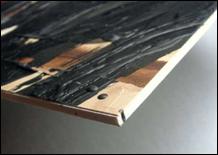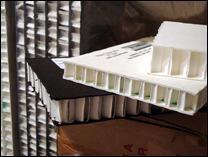 Photo 1
Photo 1
Art on 90# paper mounted to 8-ply rag, topped with encaustic.
A substrate is a surface which art is mounted to for stability and support, such as a photograph to foam center board, 8-ply rag, chip board, et al. It must be rigid enough to support whatever has been mounted to it, preferably neutral pH, easy to cut and relatively lightweight. Flat mounting is the bonding of an image to the center of a larger substrate which is then used as both mount board and decorative mat surrounding it (see pg 66, The Mounting And Laminating Handbook, 3rd Ed). This technique has been popular for decades for traditional photos mounted to aluminum and poster images mounted to colored 4-ply mat board.
8-ply Mat Board
Mat board is a multi-ply paper based product available in 4-, 6-, 8-, 10- and 12-ply thicknesses used as the natural spacer between glazing and artwork. True rag board originates from cotton linters broken down to fibers then molded into board. Museum rag board is a market phrase designed to suggest the board is a permanent, durable, stable product that would be selected by museums over rag board to safely house valuable collectibles, when actually it is most likely the same thing. Though most often used for matting, 8-ply—or thicker—rag is also used by artists as a substrate for drawing, pastel, and encaustic painting as well as a good mount board (photo 1).
 Photo 1
Photo 1
Art on 90# paper mounted to 8-ply rag, topped with encaustic.
Honeycomb Panels
On a visit to Washington DC a few years ago William Adair—frame conservator, frame historian, and master gilder— introduced me to a wonderful honeycomb panel called Tycore, which is favored by museums for mounting of valuable collectables because of its superior lightness and strength. The honeycomb interior has 7/16" cells that are the source of the board's strength and rigidity which is made of chemical pulp and adhered to alpha cellulose conservation facing boards with a polyvinyl acetate (PVA) adhesive. It is the most chemically stable fiber based honeycomb support board and is sold ¾" thick as 30"x40" and 40"x60" panels and ½" thick 48"x96" panels, both available in white only (photo 2).
 Photo 2
Photo 2
Tycore ¾" (top R); Hexamount ½" white (center) and ½" black (bottom).
Hexamount panels—a more recent development—also have hexagonal honeycomb construction with lignin-free, buffered, conservation facing paper that passes the Photo Activity Test. Both sides of the honeycomb core is surfaced with a layer of conservation board which is easily cut with sharp mat knife and metal straightedge. Available ¾" thick 30x40" and 40x60", and ½" thick 32x48" and 48x96" with either black or white virgin fiber alpha cellulose white wood pulp facing papers. This product is available in smaller sizes and is less costly because of the conservation rather than rag paper used in construction.
Panels are the perfect rigid substrate for heavy textiles, stone or marble artifacts in a shadowbox, but remember the added thickness requires more frame depth. The best news is both Tycore and Hexamount are available in the LA area through Hollinger Metal Edge, 6340 Bandini Blvd., Commerce, CA, 800-862-2228, www.hollingermetaledge.com.
END
Copyright © 2012 Chris A Paschke
For more articles on mounting basics look under the mounting section in Articles by Subject.
Additional information on all types of mounting is found in:
The Mounting and Laminating Handbook, Second Edition, 2002,
The Mounting And Laminating Handbook, Third Edition, 2008 and
Creative Mounting, Wrapping, And Laminating, 2000 will teach you everything you need to know about getting the most from your dry mount equipment and materials as an innovative frame designer.
All books are available from Designs Ink Publishing through this website.
Chris A Paschke, CPF GCF
Designs Ink
Designs Ink Publishing
785 Tucker Road, Suite G-183
Tehachapi, CA 93561
P 661-821-2188
chris@designsinkart.com